HOWL’S MOVING CASTLE (2004)
When a young woman is cursed with an old body by a spiteful witch, her only chance of breaking the spell lies with an insecure young wizard and his companions in his mobile castle.
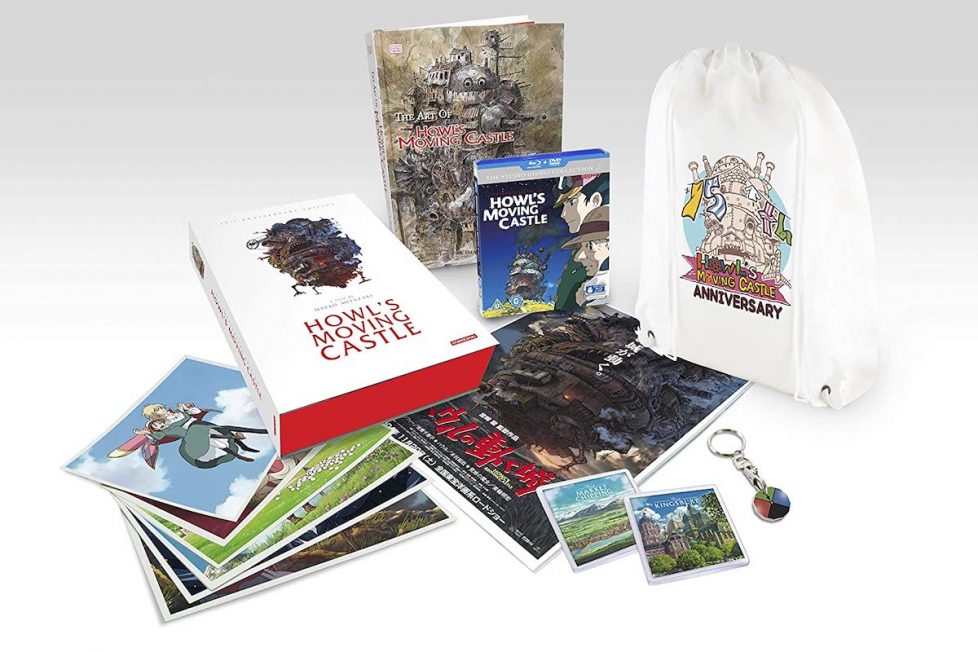
When a young woman is cursed with an old body by a spiteful witch, her only chance of breaking the spell lies with an insecure young wizard and his companions in his mobile castle.


If you’re familiar with the anime studio often cited as the “The Walt Disney of Japan”, then you know that many of its beautifully animated features have received critical acclaim. In 1985, Hayao Miyazaki and long-time collaborator Isao Takahata (Grave of the Fire Flies), founded a company that changed animation forever. Synonymous for its mesmerising animation and endearing storytelling, Studio Ghibli has produced some of the most successful animations to date. From Castle in the Sky (1986) to My Neighbour Totoro (1988), Studio Ghibli resonates with audiences of all ages.
Miyazaki’s work eluded western recognition until Spirited Away (2001) won the 2003 Academy Award for ‘Best Animated Feature’. Released in 2004, Howl’s Moving Castle is based on the novel by English writer Diana Wynne Jones. Although it remains one of Studio Ghibli’s most polarising features, it grossed over $260M worldwide. While it’s not as awe-inspiring as Spirited Away, or action-packed as Princess Mononoke (1997), it works on a similar level to Kiki’s Delivery Service (1989). Although the filmmaker’s adaptation remains unfaithful to the source material, Miyazaki brings his own sense of magic to the story… crafting a surrealistic fairy tale that represents anime at its finest.
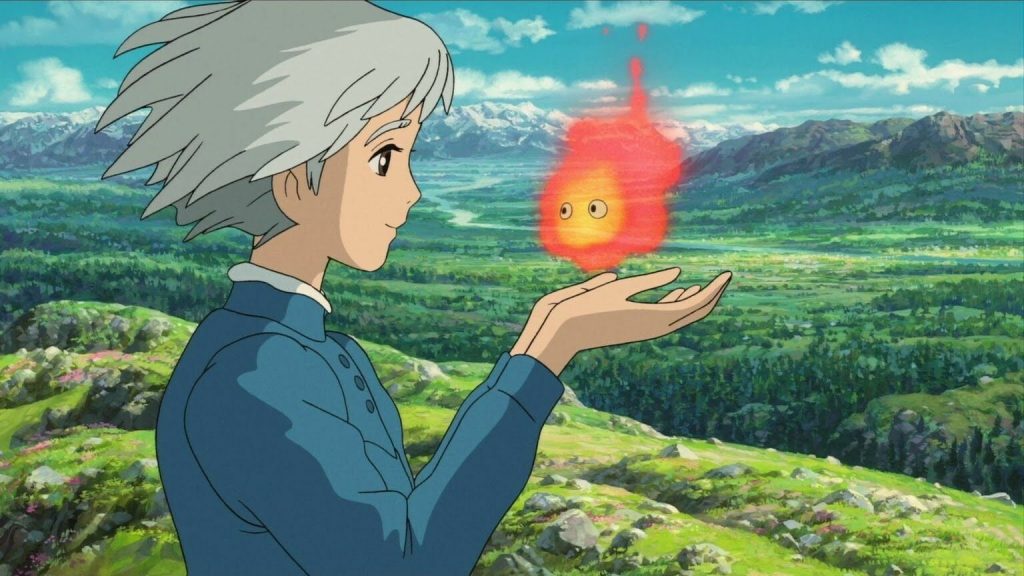
Sophie (Chieko Baisho/Emily Mortimer/Jean Simmons) is a teenage girl living an uneventful life at her late father’s hat shop. All of that changes when she befriends a wizard named Howl (Takuya Kimura/Christian Bale) who lives in a magical flying castle. After a chance meeting with the Witch of the Waste (Akihiro Miwa/Lauren Bacall), Sophie’s cursed and turned into a 90-year-old woman. Embarking on an incredible adventure to lift the curse, she finds refuge in Howl’s castle and becomes aquatinted with Mark (Ryunosuke Kamiki/Josh Hutcherson), Howl’s apprentice, and a hot-headed fire demon named Calcifer (Tatsuya Gashuin/Billy Crystal). As the true power of Howl’s wizardry is revealed, his relationship with Sophie deepens. However, as a dangerous war of sorcery threatens their world, our young heroine finds herself fighting to protect them from evil.
Before Disney acquired the distribution rights for Miyazaki’s oeuvre of films during the late-1990s, several English-dubbed versions already existed. However, Pixar CEO John Lasseter ensured further Ghibli releases would be meticulously restored, with an all-star cast re-recording the script. Actors including Mark Hamill (Castle in the Sky), Michael Keaton (Porco Rosso), and Anne Hathaway (The Cat Returns) have all provided their vocal talents. The general consensus amongst Ghibli fans is that the original Japanese versions are superior to the English dubs. I usually agree with that statement, but after watching both versions of Howl’s Moving Castle, Pete Docter’s (Toy Story 2) English adaptation remains incredibly faithful to the Japanese original. The cast do an incredible job establishing their personalities and capturing subtle nuances that were lost in translation with My Neighbour Totoro and Spirited Away. However, if one wants the authentic Miyazaki experience… then Howl’s Moving Castle should be watched in the director’s native language.
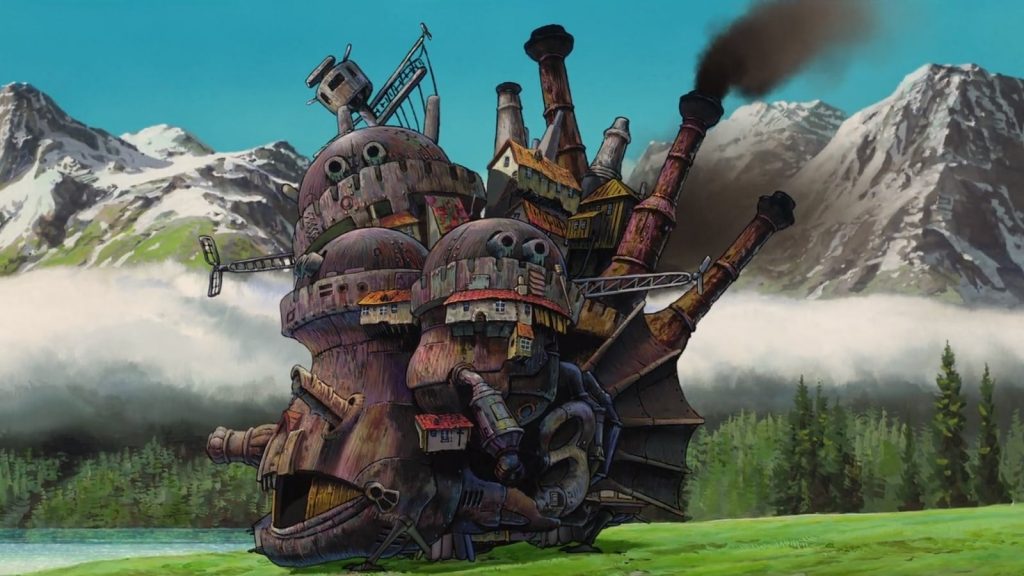
The character Sophie may be the most pivotal representative of the feminist spirit in all of Ghibli’s back catalogue. While actress-singer Chieko Baisho (Weathering With You) impressively voices Sophie both as a young girl and old woman in the Japanese version, in the English adaptation, Sophie is voiced by two actresses. Emily Mortimer’s (Mary Poppins Returns) plays young Sophie and her naturally delicate voice genuinely captures the character’s fragile nature. She does a wonderful job portraying our protagonist’s timid and insecure younger self, imbuing her with a heartwarmingly sweet personality. However, it’s Jean Simmons (Guys and Dolls) who shines as Grandma Sophie, due to her transformation, her personality and body change drastically. While she has several of her younger traits and memories, her older mentality allowed her to be more dignified and confident. Simmons adds the right amount of tremble to the elderly character, but her inflections echo of her character Estella in Great Expectations (1946). Both Mortimer and Simmons combine their talents to create a fun and fearless female lead.
After seeing Spirited Away, Christian Bale (American Psycho) was so blown away by Miyazaki’s style that he agreed to play the titular character Howl. This decision created a split reaction between Studio Ghibli fans. Several enthusiasts thought he was a perfect choice, while others declared he was miscast. Divided opinion aside, Bale captures Howl’s charming but narcissistic mindset perfectly. He intones his voice which effectively conveys both the character’s sensual appeal and unusual nature. Howl is simultaneously charming, self-centered, and caring, and Bale’s delivery excellently showcases Howl’s growing care for Sophie. There are several scenes when he speaks in a fearsome, raspy tone that will remind several viewers of his performance in Christopher Nolan’s Batman movies. Admittedly, there are several lines that sound too monotonous, but otherwise, it’s a fine performance.
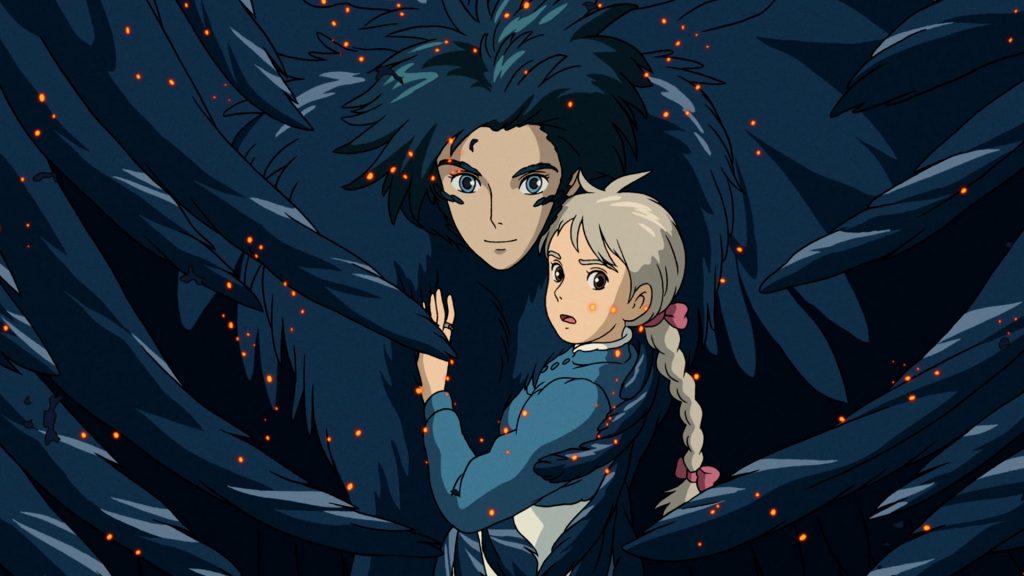
Additionally, Billy Crystal (The Princess Bride) injects some colour and witty dialogue as the truly memorable Calcifer. The self-proclaimed fire demon is somewhat similar to Phil Hartman in Kiki’s Delivery Service, only his character is less sardonic. He’s grumpy, critical, and creates several funny moments that evoke similarities to Mike Wazowski in Monsters, Inc. (2001). Notably when he’s bickering with Sophie (“You’re wearing that? After all the magic I used to make your dress pretty?”) Similar to Bale, Crystal’s performance received mixed reactions from fans. Studio Ghibli purists claimed he was an obnoxious distraction that was not complimentary to Tatsuya Gashuin’s (Spirited Away) original character. However, with the number of chuckles he emits, it’s difficult not to enjoy his performance.
The immense world-building that Miyazaki brings to the screen will forever remain the most appealing element of his features. The filmmaker’s previous works all contain their own unique creatures and showcase different sides to his imaginative mind. The imaginary world is filled with the most fantastic contraptions, particularly the flying machines that hover and float throughout. The astonishing imagery and supernatural logic make Howl’s Moving Castle one of Miyazaki’s most phantasmagorical features.
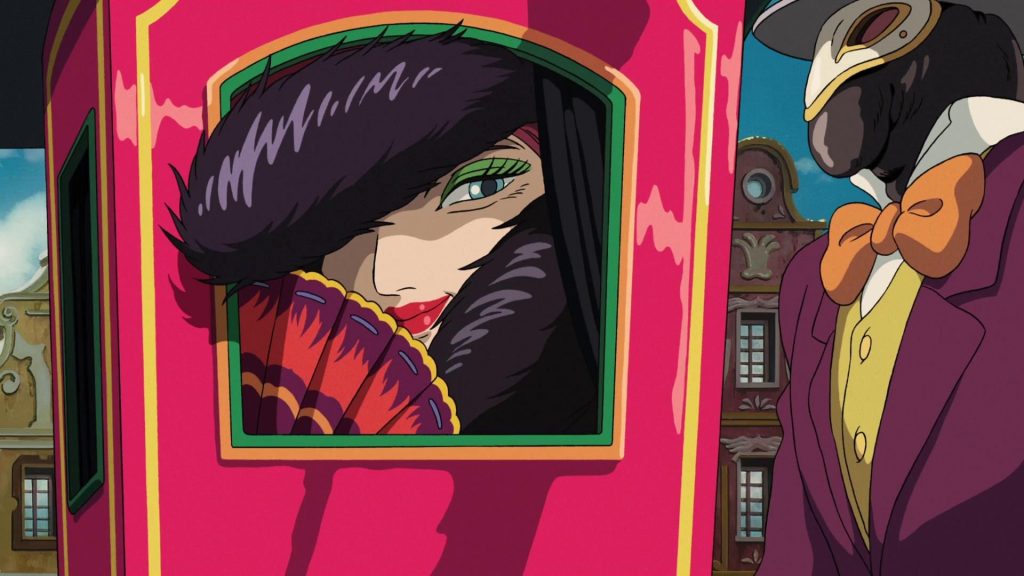
Admittedly, it doesn’t meet the high standards of Spirited Away, but the scale of imagination and creativity envelops the animation. Within the first few minutes, the Witch of the Waste’s amoebic demons bubbles from beneath paving stones, before retreating into a teapot. Along with a bouncing scarecrow wearing a top hat, who Sophie unceremoniously nicknames “Turniphead”. Perhaps the most magical element about Howl’s castle is the dial-controlled door. The door transports the occupants to different locations depending on which colour the dial’s turned to. The filmmaker’s visual playfulness and fascination with fine detail both work wonderfully with Jones’ conception of magic.
Howl’s Moving Castle features some spectacularly beautiful imagery as Miyazaki marries the traditional hand-drawn aesthetic with modern CGI techniques. This was achieved by the Studio Ghibli animators drawing the characters and painting the backgrounds by hand, before digitally scanning the image. The kingdom is filled with early 19th-century French Renaissance architecture, whereas the picturesque countryside features beautiful grassy landscapes. The range of colours and attention to detail enlivens each frame in the animated sequences. Each hand-painted background captures each flower, each insect, and each stone with the same vigour and care as with the main characters. As a result, each frame becomes a standalone piece of art. The titular moving castle itself is such a marvel and arguably the creative peak amongst the Studio Ghibli universe. The steampunk rendition of Baba Yaga’s bathhouse travels across the Wasteland upon four mechanical chicken legs. Crowned with turrets, belching smokestacks, and girders, it’s cluttered with cogs, wheels, and other mechanical appendages. Despite it being CGI, it’s as gorgeously animated and moves just as fluidly as the hand-drawn elements.
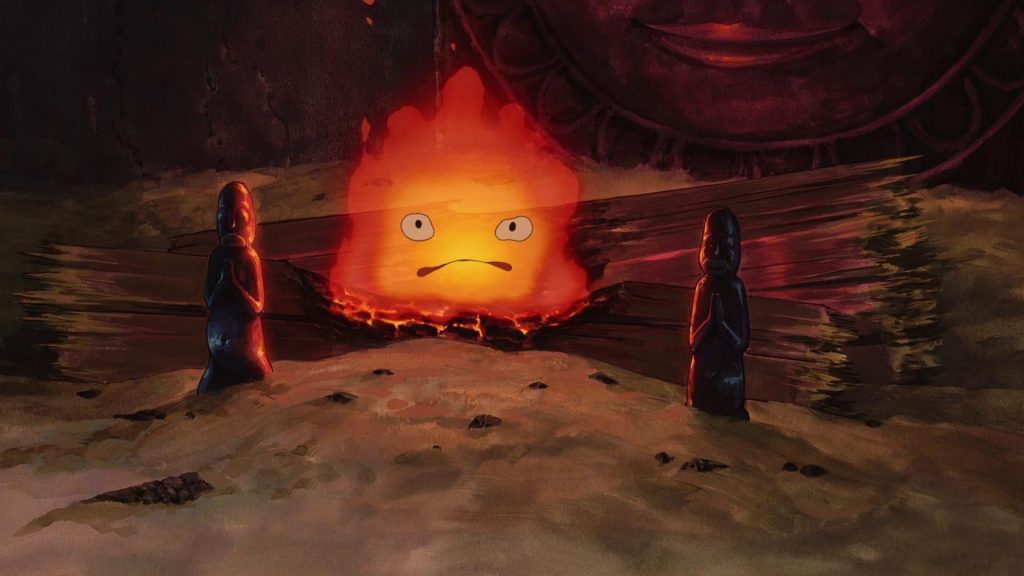
Similar to Lewis Carol’s Alice in Wonderland, at the heart of Howl’s Moving Castle is a beautiful sentiment about feminism and age. Sophie’s gender and adolescence make her the perfect Ghibli protagonist. Miyazaki stated “I wanted to convey the message to children that life is worth living.” The young Sophie is self-deprecating and alienated from her own youth. After she’s cursed and transforms into an elderly woman, she slowly accept her new persona. She’s no longer frightened of challenges or lacks confidence. Miyazaki uses several visual cues to highlight Sophie’s character growth. The most notable is when her appearance fluctuates as she finds acceptance of herself and the world surrounding her. Numerous times when Sophie exhibits bravery or selflessness, her visage is young and beautiful. However, she reverts back to an elderly lady once she begins to express self-doubt. As an old woman, she ironically begins to find her youth, eventually breaking the curse herself. Sophie’s fear of ageing is something we can all relate to and will possibly experience sometime in our lives. However, Miyazaki reminds us that each wrinkle on our face is the embodiment of wisdom and experience..
The relationship between Sophie and Howl serves as the backbone of the narrative. Similar to Princess Mononoke’s San and Ashitaka, they’re both outcasts. Howl is an outcast by nature, by sacrificing his own heart to save Calcifer he transformed into an emotionally stunted wizard. Whereas Sophie is an outcast by circumstance. Her own fears of mediocrity and beauty are brought to life by the Witch’s curse, literally forming a new identity. Their relationship evokes similarities to Beauty and the Beast (1991), however, both characters have their own ‘beast curse’ due to the Witch. Throughout we see two characters form a genuine sense of compassion growing between them, forming an understanding for one another. One could argue Miyazaki’s idea of indiscriminate love and compassion ending a curse is an unrealistic prospect. However, teaching his younger audience that with a kind heart and good intentions anything is possible is a wonderful message. Howl’s Moving Castle focuses on how understanding and love can solve problems, rather than resorting to conflict.
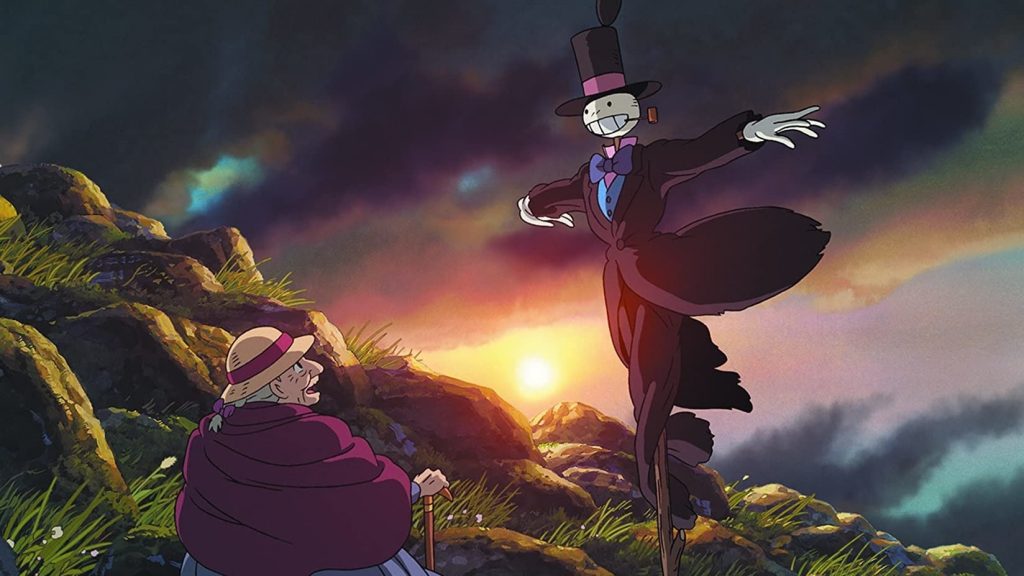
War is a common theme seen in writer-director Miyazaki’s pictures. As a child, he experienced the hardships of World War II, which had a strong impact on his life. From Nausicaa of the Valley of the Wind (1986), through Porco Rosso (1992) to Princess Mononoke, Miyazaki’s opposition to militarism frequently act as a thematic strand. Howl’s Moving Castle serves as the filmmaker’s cinematic protest against the Iraq war. Although the antagonist Madame Suliman (Blythe Danner) never explains why the two kingdoms are at war, a brief piece of dialogue informs us that a prince has been kidnapped. The vagueness allows for greater exploration of the destruction caused, such as the extensive firebombing scenes towards the film’s conclusion. Additionally, Miyazaki explores the inflictions amongst the innocent civilians that engage in war—particularly, Howl, who lives in a state of despair as he’s caught up in the violence he cannot stop. During one scene as a battleship looms over our protagonist’s idyllic garden, Sophie asks “it is the enemy’s, or one of our own?” Howl replies “What difference does it make?” Miyazaki’s message is simple enough, war is instigated too often by individuals for their personal gain.
Howl’s Moving Castle is a beautiful animation from Hayao Miyazaki and its heartwarming message will resonate with audience of all ages. It’s a compelling coming-of-age tale that touches upon pertinent topics such as self-worth, war and compassion. Although it’s not considered one of Studio Ghibli’s renown classics, it’s an incredibly fun adventure filled with colourful characters and astounding visuals. Admittedly, the last act is ever so slightly disappointing and leaves several questions unanswered. While the story is entertaining, the final revelations about Howl’s past are a little underwhelming. Nonetheless, Miyazaki reminds us that not only is he a master of his craft, but love is the ultimate force.
If you enjoyed reading this review, please support my writing and buy me a coffee.
JAPAN | 2004 | 119 MINUTES | 1:85:1 | COLOUR | JAPANESE • ENGLISH (DUBBED)

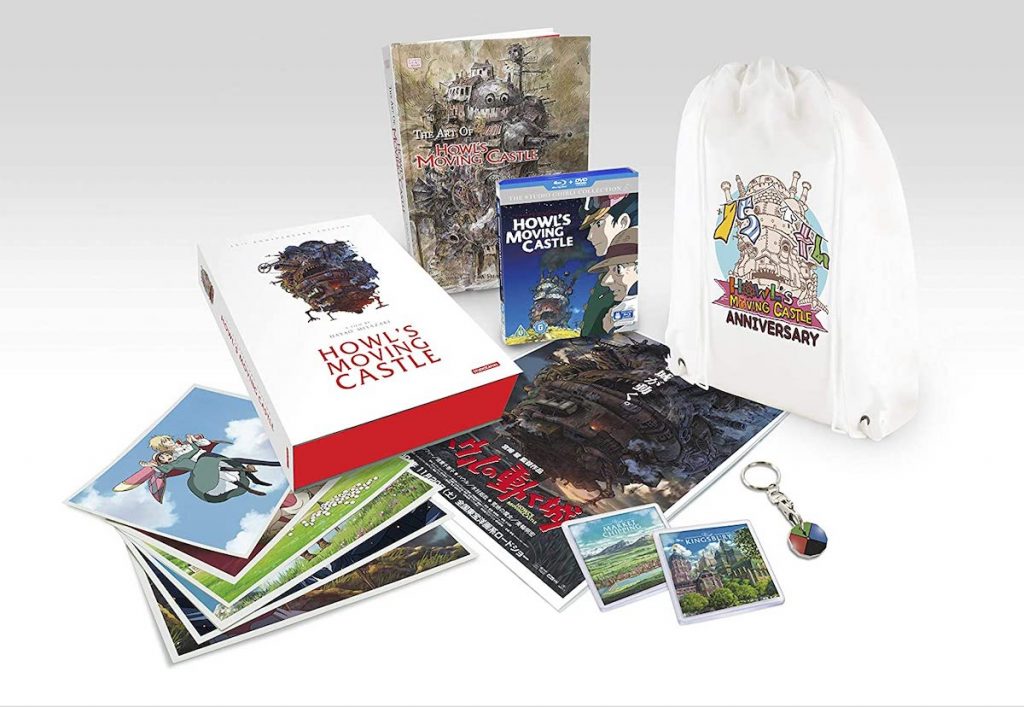
Search the Wastelands all you like, but you won’t encounter any issues with this stunning transfer. Presented in the original 1:85:1 aspect ratio and 1080p/AVC encoded video, Howl’s Moving Castle is a magnificent animation. Miyazaki’s colour palette is filled with vibrant primaries, inky blacks, and rich contrast. The animator’s line art is naturally defined and the hand-painted backgrounds showcase every brush stroke. Whereas the blending between CGI and hand-drawn artwork is seamless. The shooting stars are a wonderful example of the excellent use of both animation techniques. Details and character expressions remain crystal clear with grain and source noise is nowhere to be seen. Howl’s Moving Castle is a masterclass in artistry and Studio Ghibli fans will be swept away by its striking presentation.
Both the original Japanese version and English dub receive a DTS-HD 5.1 Master Audio Surround track. Additionally, the Japanese version features optional subtitles for Studio Ghibli purists. After listening to both audio options, despite the language, there’s not much difference between the two. The dialogue is clear throughout and the voice actors suit their roles well. The surround sound experience sounds superb, making full use of the soundstage with the thunderous presence of the castle. The rear channels immediately light up with sounds of mechanical turbines, rusty metal, and pressured steam escaping the exhausts. Whereas the raucous city scenes create an immersive atmosphere. The most notable feature is the beautiful mellow and atmospheric score from long time Miyazaki collaborator Joe Hisaishi (Castle in the Sky). The soft keys will sound like a lullaby for children but will stir up plenty of emotions for older viewers.
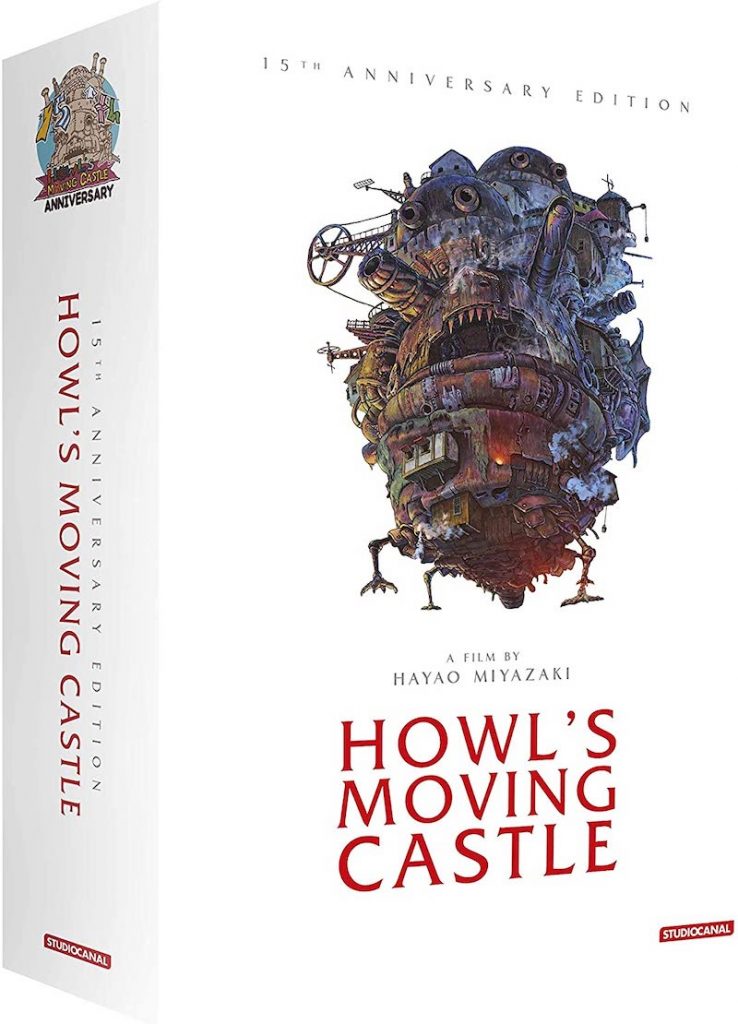

director: Hayao Miyazaki.
writers: Hayao Miyazaki (based on the novel by Diana Wynne Jones).
voices: (Japan) Chieko Baisho, Takuya Kimura, Akihiro Miwa, Ryunosuke Kamiki, Haruko Kato & Daijiro Harada • (USA) Jean Simmons, Christian Bale, Lauren Bacall, Blythe Danner, Emily Mortimer & Billy Crystal.
